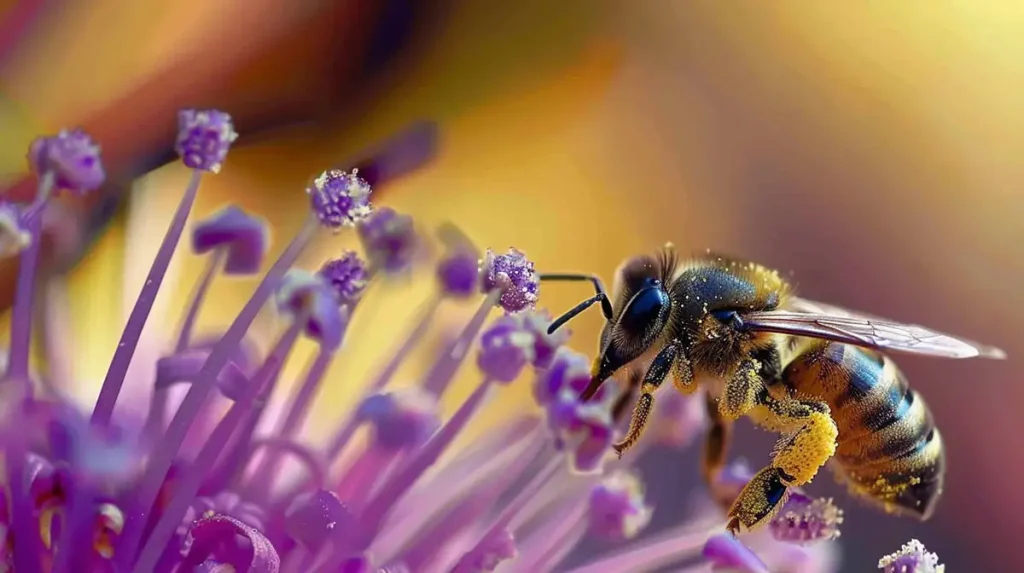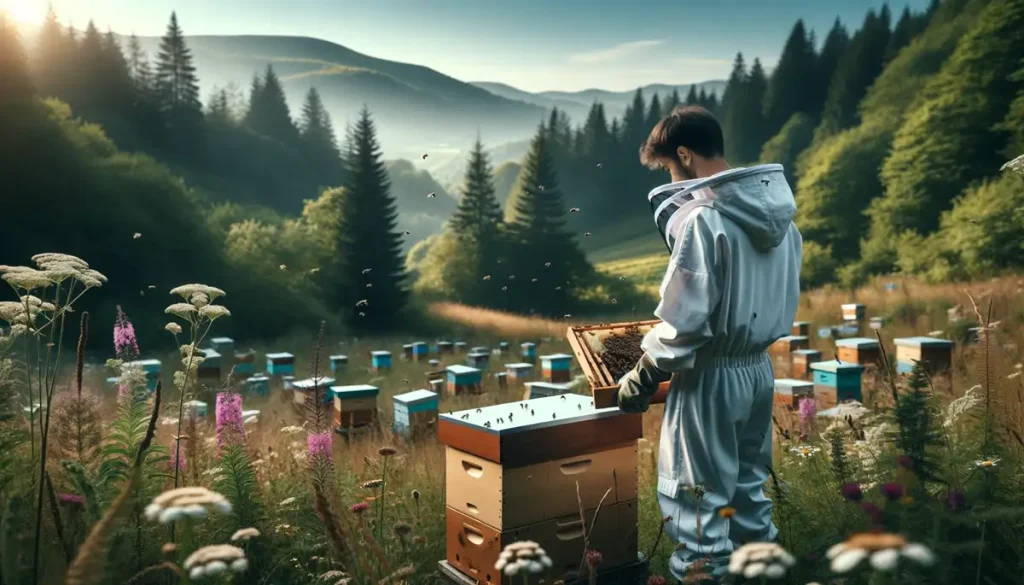Table of Contents
If honey comes from nectar – and nectar from flowers – would the flowers have something to do with how it ends up tasting? Indeed they do. And with the endless variety of flowers that the honeybee will happily pollinate comes a breathtaking range of honeys which can be made. Honey is, in fact, almost never the result of one species of flower’s nectar. Consider the many diverse flowers that bloom in an average backyard, field, glade, riverside, etc. and you begin to get the idea. Honeybees sure get around. There are many trace substances in nectar, and it is the different proportions thereof that create different types of honey. But what if you are aiming for something specific?
Nomadic beekeeping is all about the principle of “different flowers, different honey.” Any more than one or two hives and it becomes pretty impractical to plant out the flowers that will yield the specific nectar required. Much better, then, to take things on the road – to become a nomad – and to transport the hives themselves to those locations where certain types of flowers are in abundant bloom. This is nomadic beekeeping, and it is closely associated with the concept of monofloral honey. Monofloral honey is so described as that which is at least 40% composed of nectar for a single species of flower. To create monofloral honey, nomadic beekeeping is pretty much the only way, following naturally occurring blooms from place to place to encourage bees to pollinate precisely the flower that is desired.
Monofloral honey is highly sought after, boasting distinctive flavors and unusual notes, which honey aficionados seem only too happy to shell out for time and again. Yet the rule of thumb really does seem to be: “If you want bespoke or unusual honey, you have to go where the flowers are (with your bees).” Nomadic beekeepers are a phenomenon the world over, with each region’s distinctive flora meaning the nomadic beekeepers from Romania make quite a different honey to those in Turkey.
For nomadic beekeepers, beekeeping moves to nature’s natural rhythms. A highly seasonal endeavor, nomadic beekeepers have to travel where and when their target flowers will be in bloom. Thus, nomadic beekeepers are truly in tune with nature, trailing wagonloads of beehives to the locations where the local nectar flow is the right nectar flow. As a result, the lives of nomadic beekeepers can involve whole seasons away from home and family – no walk in the park by any stretch.
How Nomadic Beekeepers Operate
Although any honey made with at least 40% nectar from a single flower species can be classified as monofloral, it is not like any old species will do. Monoflorality only means the beekeeper can be sure what flower’s nectar has gone into the honey, it does not say anything about the quality of the final product. A honey could well be technically “monofloral” yet not particularly impressive in the taste department.
Additionally, although “monofloral honey” might sound impressive, it is not a widely known term and the honey-loving public are much more attracted by words like “acacia”, “lavender”, “citrus,” and “chestnut”. All of this is to say that there are certain flowers more valued than others, which will produce well-known and renowned honey flavors. That is what people pay for.

It is precisely these flowers that nomadic beekeepers chase, dancing to the tune of their specific blooming seasons and relative geographical distribution. Accordingly, Turkish nomadic beekeepers follow the endemic flowers of the Ovacik district and there are even Nepalese beekeepers who brave cliff faces to harvest a very unusual type of honey created with nectar from flowers endemic to those most inhospitable environments.
As you will have surely guessed by now, nomadic beekeeping takes planning – and a lot of it. After collecting information on where and when their target flowers are set to bloom, nomadic beekeepers will plan a meticulous route and schedule the length of time they will stop at each location to allow their bees to pollinate the local flowers.
A nomadic beekeeper can expect to move roughly three or four times during a single season and in this we can see the economic incentive at play. If your apiary is static, your honey production is not only limited to nectar from nearby flowers, but you will also only produce honey when these are in bloom. Nomadic beekeeping simply brings bees into contact with more flowers over the course of a single season. Nomadic beekeepers might often be in one location until the next one blooms. Put simply, they get more honey – and more of something that rhymes with honey.
There are also bee colony health benefits to nomadic beekeeping. The quality of a bee’s forage area is a life-or-death matter for a colony, and they would have a much better chance of sufficient nourishment if that forage area was massively expanded with addition of wheels under the hive. Indeed, there is compelling evidence that bees from nomadic colonies will grow faster during the crucial spring months compared to those from static colonies. Nomadic bees are also less at risk from local pesticides and other harmful chemicals as, of course, they can simply move to avoid them.
Transportation
In the modern world, nomadic beekeepers will typically transport their beehives on wheels, most often with a trailer. This method allows apiaries of considerable size to be moved (and if you’re going to all this trouble, you might as well make as much honey as possible) and is also quite necessary for going the distances involved. Flower distribution is dependent on climate and other environmental factors – these do not tend change too much over small areas.
Apiaries can be stacked onto trailers to be moved or beekeepers might enlist the help of a custom-built apiary trailer, which maximizes space and allows for smoother transportation of the hives. As is widely known in the world of beekeeping, disturbing hives is not recommended (even with garden hives, it is recommended only to move them so much at a time). Accordingly, making this journey as smooth as possible is very much in the beekeeper’s interests. Even with an apiary trailer, moving around hives will always pose at least some trouble, which leads me on to…
- Carter, Anthony (Author)
- English (Publication Language)
- 194 Pages - 02/28/2024 (Publication Date) - Independently published (Publisher)
Issues with Nomadic Beekeeping
Bees are at risk of – but also transmit – diseases. While nomadic beekeeping can be seen as a means of moving bees away from diseases, the obvious flipside of this is that it is also a means of spreading diseases by transporting infected bees hundreds of miles. Studies in Australia have shown that the increase in nomadic beekeeping has led to an increase in hives, the country over, succumbing to disease.
There is also the issue of land use. In most jurisdictions, permission will have to be granted by landowners. Setting up a large apiary with countless swarming bees is no small matter and the situation could arise where the nectar flow that is most needed is on the land of someone disinclined to have bees around.
Is Nomadic Beekeeping for Me?
Nomadic beekeeping is undoubtedly a lot of work and pretty much needs to be your day job. Nomadic beekeepers have to travel long distances (meaning you can’t do it part time), set up a great deal of bulky equipment in each new area, navigate local landowners to make sure they have permission to set up – and all of this before the actual work of beekeeping has begun.
Yet, despite the arduous work involved (nomadic beekeepers will also work long hours to ensure they collect enough of the valuable honey to make a profit after fairly large initial costs) many people have been attracted to this lifestyle, and the movement is growing. Like many “nomadic” things, there is an attractive spiritual element to nomadic beekeeping. Not only does nomadic beekeeping let you see a lot of nature, but you also become more intimately connected with it by knowing whether or not it will support the creatures who rely on your care. Many people find the lifestyle a true escape from the rat race.
What is Nomadic Beekeeping – Conclusion
In conclusion, nomadic beekeeping is a unique and challenging approach to beekeeping that involves moving hives across different regions and environments to maximize honey production and pollination services. This method is often used by commercial beekeepers who have large-scale operations and need to follow blooming patterns of various crops. Nomadic beekeeping can offer numerous benefits, including increased yields and diversity in honey production, as well as opportunities to provide pollination services to different agricultural regions. However, nomadic beekeeping also presents unique challenges, such as transportation logistics, hive management in unfamiliar environments, and exposure to new pests and diseases. Therefore, it is important for nomadic beekeepers to have a deep understanding of beekeeping techniques, hive management, and regulations in different regions. In addition, it is important for nomadic beekeepers to prioritize the health and wellbeing of their bees and take steps to mitigate stress and exposure to environmental toxins. With careful planning, preparation, and dedication, nomadic beekeeping can be a rewarding and lucrative option for commercial beekeepers looking to expand their operations and provide important services to the agricultural industry.
Looking to up your beekeeping game? Check out our latest product recommendations so you can take things to the next level!
Introducing The Top 12 Best Beekeeping Veils For 2024
Introducing The Top 20 Best Beekeeping Gloves For 2024
Introducing The Absolute Best Beekeeping Suits For 2024
The 15 Top Beekeeping Books for 2024
The Top 11 Honey Extractors for 2024
The Top 12 Mason Bee Houses for 2024
Beekeeping Disclaimer:
Beekeeping, like any agricultural activity, involves inherent risks. It is important to understand these risks and take appropriate measures to mitigate them.
Potential risks associated with beekeeping include:
- Bee stings: Honey bees are generally not aggressive but can become defensive if they feel threatened or their hive is disturbed. Bee stings can cause allergic reactions or even anaphylaxis in some individuals, which can be life-threatening. It is important to wear protective clothing and follow best practices when handling bees to minimize the risk of stings.
- Diseases and pests: Bees can be vulnerable to various diseases and pests, including mites, viruses, and bacterial infections. These can have significant impacts on bee colonies, leading to reduced honey production or even colony collapse. It is important to monitor hives regularly and take appropriate measures to prevent and treat diseases and pests.
- Weather conditions: Extreme weather conditions, such as drought or cold temperatures, can affect the health and productivity of bee colonies. It is important to ensure that hives are appropriately sheltered and provided with adequate food and water.
- Environmental hazards: Bees can be affected by environmental hazards such as pesticide exposure, pollution, and habitat loss. It is important to be aware of these hazards and take appropriate measures to protect bee colonies and promote healthy environments for bees.
- Legal requirements: Beekeeping may be subject to local, state, or national regulations, such as registration or inspection requirements. It is important to be aware of these requirements and comply with them.
While beekeeping can be a rewarding and enjoyable activity, it is important to be aware of the potential risks and take appropriate measures to mitigate them. By following best practices and staying informed about the latest developments in beekeeping, beekeepers can help ensure the health and productivity of their hives and contribute to the well-being of bee populations worldwide.
Last update on 2024-04-17 / Affiliate links / Images from Amazon Product Advertising API


